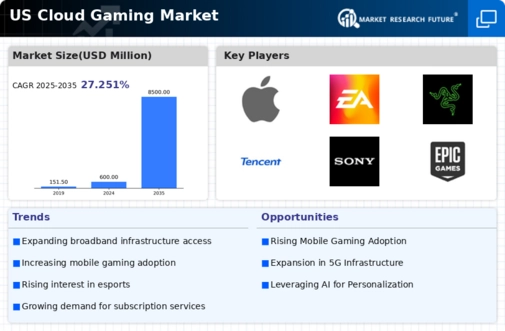Expansion of Internet Infrastructure
The cloud gaming market is significantly influenced by the expansion of internet infrastructure across the United States. With the rollout of 5G technology and improved broadband access, more consumers can access high-speed internet, which is essential for cloud gaming. Reports suggest that as of 2025, approximately 85% of households have access to high-speed internet, facilitating smoother streaming experiences. This enhanced connectivity allows gamers to engage with cloud gaming services without the interruptions that plagued earlier platforms. Consequently, the cloud gaming market is poised for growth, as improved internet infrastructure enables a broader audience to participate in cloud gaming, thereby increasing market penetration and revenue.
Emergence of Competitive Gaming and Esports
The emergence of competitive gaming and esports is a significant driver for the cloud gaming market. As esports gain mainstream recognition, the demand for accessible gaming platforms increases. Cloud gaming services provide an ideal solution, allowing players to participate in competitive gaming without the need for high-end hardware. In 2025, the esports market is projected to reach $1.5 billion, further fueling interest in cloud gaming. This trend encourages cloud gaming providers to enhance their offerings, catering to both casual and competitive gamers. The cloud gaming market is thus positioned to capitalize on the growing esports phenomenon, attracting a diverse range of users and fostering community engagement.
Growing Popularity of Cross-Platform Gaming
The cloud gaming market is witnessing a growing popularity of cross-platform gaming, which allows players to engage with games across various devices. This trend is reshaping the gaming landscape, as it enables users to switch between consoles, PCs, and mobile devices seamlessly. Approximately 60% of gamers express a preference for cross-platform capabilities, indicating a shift in consumer expectations. As a result, cloud gaming providers are increasingly focusing on developing platforms that support cross-play functionality. This evolution not only enhances user engagement but also expands the potential audience for cloud gaming services. The cloud gaming market is thus adapting to these preferences, ensuring that it remains relevant in a rapidly changing gaming environment.
Increased Investment in Gaming Technologies
Investment in gaming technologies is a critical driver for the cloud gaming market. Major tech companies are allocating substantial resources to develop and enhance cloud gaming platforms. For instance, investments in artificial intelligence and machine learning are being utilized to optimize game streaming and improve user experiences. In 2025, it is estimated that investments in gaming technologies will exceed $10 billion, reflecting the industry's commitment to innovation. This influx of capital not only accelerates the development of new features but also enhances the overall quality of services offered. The cloud gaming market benefits from these advancements, as they attract more users and foster a competitive environment that drives further innovation.
Rising Demand for High-Quality Gaming Experiences
The cloud gaming market is experiencing a notable surge in demand for high-quality gaming experiences. As gamers increasingly seek immersive and visually stunning gameplay, the industry is responding by enhancing streaming quality and reducing latency. Recent data indicates that 70% of gamers prioritize graphics and performance, which drives cloud gaming providers to invest in advanced technologies. This trend is likely to continue, as the expectation for seamless gameplay grows. The cloud gaming market is thus compelled to innovate, ensuring that users can enjoy AAA titles without the need for expensive hardware. This shift not only attracts casual gamers but also retains hardcore enthusiasts, expanding the overall user base and revenue potential.

















Leave a Comment